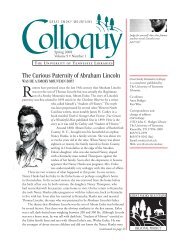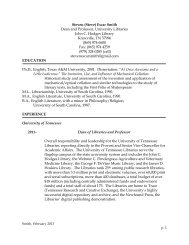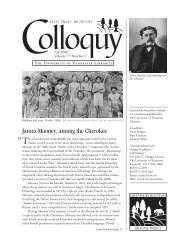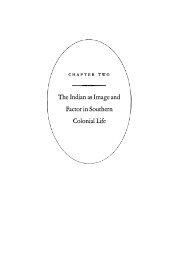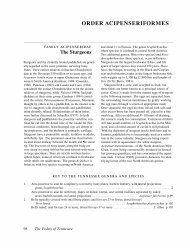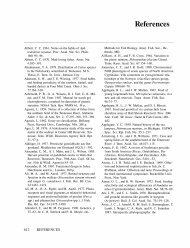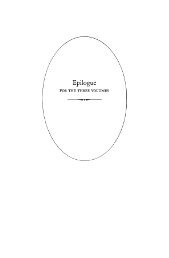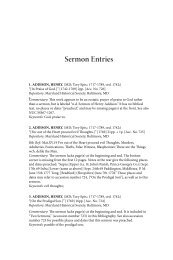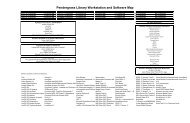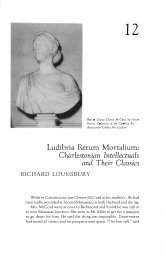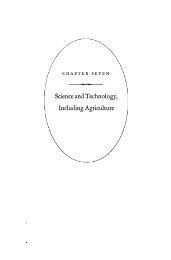Literature, Principally Belletristic - University of Tennessee, Knoxville
Literature, Principally Belletristic - University of Tennessee, Knoxville
Literature, Principally Belletristic - University of Tennessee, Knoxville
You also want an ePaper? Increase the reach of your titles
YUMPU automatically turns print PDFs into web optimized ePapers that Google loves.
· INTELLECTUAL LIFE IN THE COLONIAL SOUTH '<br />
above that author claimed to be a native <strong>of</strong> Carolina, and Kirkpatrick<br />
was not.268<br />
The Gazette between 1740 and 1755 carried a few narrative and ballad<br />
pieces. The only original narrative poem <strong>of</strong> any length is Joseph Dumbleton's<br />
"The Northern Miracle," a Rabelaisian tale in a rural setting in<br />
Northumberland. A friar and a tongue-in-cheek miracle are the elements<br />
<strong>of</strong> this piece published January 8, 1750. Probably not <strong>of</strong> local origin is<br />
"Insulted Poverty: Or, the Case is Altered. A Tale," March 27, 1745, nor<br />
is the briefer ballad "The Countryman's Lamentation" <strong>of</strong> September 30,<br />
1745, probably colonial. And though "On Vice-Admiral Vernon's taking<br />
Porto Bello," to "the Tune <strong>of</strong> -Sally" (June 14, 1740), was a ballad<br />
reflecting a strong South Carolina interest in the War <strong>of</strong> Jenkins' Ear, there<br />
is no evidence that it was a local contribution. If "A Black Joak Blazing,<br />
or, The secret History <strong>of</strong> Caesar & Dianna, A Poem Humbly inscribed to<br />
Miss Bold-J oak" which was advertised to be printed in the December 5,<br />
1741, issue, had appeared there would have been another locally authored<br />
ballad, obviously satirical, published in the colony.<br />
Perhaps the most ambitious <strong>of</strong> South Carolina narrative verses was<br />
The Sea-Piece: A Narrative, philosophical and Descriptive POEM. In Five<br />
Cantos, published in London by James Kirkpatrick, M.D., in 1750. In 1749<br />
the physician had published separately Canto II and evidently received<br />
sufficient encouragement to bring out the whole, with a fulsome and<br />
lengthy dedicatory epistle to Commodore George Townshend, who had<br />
brought Kirkpatrick and his family back to England. The dedication <strong>of</strong><br />
twenty-five pages is followed by a preface <strong>of</strong> twenty-three, and although<br />
both these prose passages are in general effect quite tedious, they tell the<br />
reader a good deal about the author, including his classical learning, the<br />
object <strong>of</strong> the poem, and his critical theory regarding such verse.<br />
The Sea-Piece was received and read in Great Britain and in the colonies<br />
in its time and in fact is one <strong>of</strong> the principal eighteenth-century efforts by<br />
a colonial to produce a major poem, though its composition was perhaps<br />
largely in Britain. It is a topographical poem <strong>of</strong> the subspecies seapiece, as<br />
its title indicates, and as its author indicates in his prose comments that it<br />
represents a modern attempt in an ancient form. In the dedication he de<br />
clares that aboard the Tartar from Carolina he received from his patron<br />
an instruction in "maritime Images and Observations" which greatly en<br />
riched his verses. Among other digressions in this dedication, the physician<br />
poet mentions and quotes Addison's Cato, Pope's Iliad, and his own<br />
Nonpareil mentioned above.<br />
In his preface the writer finds it difficult accurately to classify his poem<br />
as nautical, didactic, or representing precisely any one <strong>of</strong> the descriptive<br />
terms he employs in the title. He confesses that he had composed a shorter



